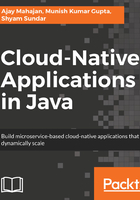
Monolithic transformation
Enterprises have been running channel applications built on JEE principles running on clusters of application servers. These applications have accumulated a lot of technical debt over the years and have become a major issue—large, unwieldy, and resistant to constant change.
With the increase in competition in the business environment and the proliferation of the channels, businesses are looking for faster innovation and to provide seamless customer experience. On the other hand, they do not want to throw away the existing investment in the existing applications.
In this scenario, enterprises are undertaking multiple programs to re-factor and re-architect the existing applications into modern, distributed, microservice-based models that provide the currency of rapid iteration and are future-proof.
Enterprises are attacking this problem in a two-prong manner:
- Setting the base platform that provides the core ecosystem as a set of services to deploy and run the microservices. These services include Configuration Management, Service Discovery, Elastic Compute, Container Management, Security, Management and Monitoring, DevOps pipeline, and more. Enterprises typically weigh in between using the public cloud and setting up a private cloud. The choice of cloud platform depends on the industry in question and the maturity of the enterprise strategy.
- The second approach is to chip at the monolithic application, one functional piece at a time, and migrate the core business logic to the microservice model. The GUI part is separately migrated to an SPA model using frameworks such as AngularJS and ReactJS. For example, a lot of e-commerce enterprises have moved their catalogue and search services to elastic cloud providers. Only when the customer clicks the checkout do they bring the customer to the in-house data center.
Once the enterprise has set up the ecosystem with respect to platform services, the ability to add more microservice-based functionality becomes easy, providing the required impetus in terms of business agility and innovation.
We will cover digital transformation in more detail in Chapter 12, Digital Transformation.